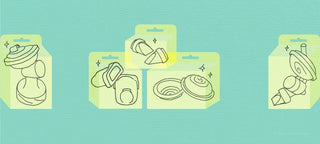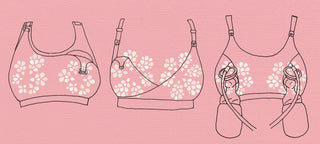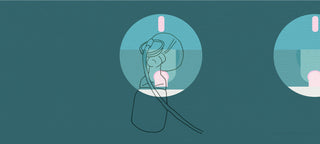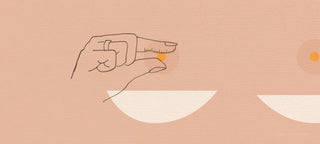Why, what, when and how to rejuvenate your pump parts
Skip the intro, I want the info
In Dani's first month of breastfeeding, she found herself predominantly pumping due to her baby having a tongue tie. After every use, she would carefully wash and sterilise all her pump parts. Dani understood that this rigorous cleaning was an important step in keeping her little one safe. What she didn't yet appreciate was how wearing her constant use and cleaning was on those pump parts. In fact, like many of us starting out pumping, Dani had no idea that she would ever, let alone regularly, need to replace parts like the valves and membranes on the pump she was using.
One evening, Dani noticed how full she felt and began to worry she may have clogged ducts. Despite diligently pumping overnight, she was still engorged with milk the next morning. It was then that a niggling feeling began. Could it be that her much relied upon pump was faltering? Having no alternative at hand, Dani continued to pump even as she became certain that much of her milk was being left behind.
Soon after, on a visit to her in-laws for dinner, Dani brought her manual hand pump to use for the night. When it came time to pump, Dani was surprised and delighted with how quickly she was able to fill her daughter's bottles. Relief washed over her as she felt properly drained of milk once again, and her suspicions about her main pump's diminished performance were validated.
Back home, after some troubleshooting, Dani confirmed that the pump in question was technically working fine and reasoned that it must indeed be the pump parts themselves in need of replacement. Dani realised that as the pump parts had gradually lost efficiency, she'd been spending more and more time pumping to get the same results - on top of everything else she was tackling each day as a new parent. And, though grateful to have pinpointed her issue, she could see how stressful it had been to be stuck in the dark, without helpful guidance on how to keep her pump working well for her.
Dani quickly jumped online and ordered new parts, managing the short wait for them to arrive with her manual pump. Thankfully, a few days later, her new pump parts arrived and huzzah! Everything worked perfectly again, and Dani felt properly drained after much less time pumping! Understanding how to properly maintain the performance of her pump meant Dani was able to establish a successful exclusive pumping regime when the need arose. Also made easier was Dani's decision to continue pumping and building a supply of breast milk for her daughter that would last right through to the birth of her next baby! Woo!
Ever feel so under the pump you find yourself letting your performance slide and hoping no one notices? Your breast pump parts do...

Breast pump parts wear out. Consider it a badge of honour. The good news is: new parts = new pump! Let us take you through why, what, when and how to replace and recycle your worn out parts so you can enjoy optimum performance from your breast pump once more. Save time, pressure, battery and output by following our helpful tips below.
Ok, so what parts on my breast pump are we talking about?
Well, we'll go into more detail on each one, but essentially, we're looking at all the plastic and silicone parts that connect to your pump motor.
Why do breast pump parts even need replacing?
When the parts required to deliver the suction wear out, it will undermine the performance of your otherwise wonderful pump. Nobody's got time for that. For the parts that come in contact with your breast milk, it's essential that these are replaced frequently, so that they are safe and free from scratches or damage (ironically, most commonly caused by the cleaning process) that can harbour bacteria.
What are the benefits of replacing breast pump parts?
Ensuring that breast pump parts responsible for suction are in great working order will pay dividends in terms of:
- Optimal breast milk expression which means minimising time on the pump;
- Optimal power efficiency means you're able to use the lower levels of the pump's range, which uses less battery and is typically quieter and more comfortable; and
- Protection for your supply through more effective drainage.
Replacing breast pump parts that are in contact with your breast milk is beneficial for keeping your milk safe and free from any build up of contaminants that might make your little one unwell.

How do I know when my breast pump parts need replacing?
Your pump manufacturer should provide a recommended schedule for the turnover of each part, usually listed on the product description and packaging for each part.
We've summarised ours here, which you can use as a general guide:

Why do the pump parts wear out at different rates?
If you're curious as to why each part has a particular lifespan, you can click on their names (in green) below to see a full explanation. Otherwise, feel free to skip ahead to cleaning considerations and responsible recycling of your spent parts.
1. Parts that are the main drivers of pump performance will be the first to wear out.
Valves work in tandem with membranes to create a vacuum seal within the valve base of your pump and provide adequate stimulation to your nipple. This means the entire time you are pumping these silicone parts are subjected to stress and eventually, that means their elasticity will weaken over time and compromise the ability of the pump motor to deliver effective suction.
Valves

Valve lifespan: 2–4 weeks for frequent pumping, or 2 months for daily pumping
Remember how your pump came with a spare set of duckbill valves? That’s because these little, unassuming parts are absolutely crucial to the functioning of your pump and require a high turnover frequency.
The one-way valve's little duckbill opening lets out the excess pressure created by air or milk into your pump's collection cup, bottle or bag. Over time, as the valve material and opening become weakened by use or rough cleaning, it will let more and more pressure out. When too much of the pressure escapes, there won't be enough to stimulate your nipple and express your milk as effectively.
Membranes (Round Membranes and U-Membranes)

Membrane lifespan: 2–3 months
The membrane is the barrier that transfers the vacuum pressure (mmHg) coming from your pump motor or its tubing into the space created by the valve base. The membrane, valve and flange all connect into and seal off the valve base when your nipple is in place. In this way, the pump's suction is introduced through the membrane, trapped by the one-way valve, concentrated at the nipple and released through the valve as puffs of air and, post-letdown, drips of precious milk!
Over time, this constant pressurisation has a weakening effect on the membrane, limiting its ability to translate the pressure from your pump to the valve base in full. When too little pressure is transferred, there won't be enough to stimulate your nipple and express your milk as effectively.
If either or both of these parts already need replacing you may have noticed:
- you need to pump for longer to achieve your usual output
- you are using higher suction levels than usual
- the edges of the valve's duckbill may no longer press together
- there may be tears visible in the silicone
To be proactive, replace according to the following recommendations:
- Valves: every 2–4 weeks for frequent pumping or every 2 months for daily pumping
- Membranes: at the first signs of wear, if damaged or every 2–3 months
2. Parts that are in contact with your body or breast milk will be most susceptible to bacteria growth.
Breast milk itself has brilliant antimicrobial and antibiotic properties, which help to bolster your baby's growing immune system beautifully. That said, breast milk (and its residue) definitely has a shelf-life, and harmful microorganisms will be able to grow in it if given the opportunity. This can happen if parts are not cleaned adequately, or where bacteria dodges cleaning efforts by hiding in surface scratches, and where parts are assembled or stored without being completely dry.
Breast Shields and Breast Shield Convertors

Plastic breast shield and breast shield convertor lifespan: 3 months
Silicone breast shield lifespan: 6 months
Breast shields and convertors sit against your skin and form a connection with the valve base and a seal around your nipple. This constant, pressurised contact with your skin provides easy access for any skin-borne bacteria to work its way into any available scratches on the surface of parts, as well as into your milk. Plastic breast shields can become brittle over time, mainly due to the extreme temperature changes required for sterilisation and any exposure to UV. The silicone breast shields used for our wearable pumps and cups tend to be thicker, softer silicone and with proper care enjoy a longer life.
Valve Bases and Cups

Valve Base and Cups lifespan: 3 months
Valve bases and cups are the pump parts that your milk passes through or into, and as such they need to remain as clean as possible. The shape of the valve base makes it tricky to get into and clean all the nooks where residue can build up. The collection cups themselves are the equivalent of bottles – both need regular replacement to ensure your milk is stored safely, albeit temporarily.
If one of these parts already needs replacing you may have noticed:
- there is a buildup of residue on the surface of the part
- there may be scratches visible in the plastic or silicone surface
To be proactive, replace according to the following recommendations:
- Plastic breast shields/flanges: at the first signs of wear, if damaged or every 3 months
- Silicone breast shields: at the first signs of wear, if damaged or every 6 months
- Breast shield convertors/flange inserts: at the first signs of wear, if damaged or every 3 months
- Valve base: at the first signs of wear, if damaged or every 3 months
- Cups: at the first signs of wear, if damaged or every 3 months
3. Meant-to-stay-dry parts that can trap condensation and dust are the most difficult to clean.
In a closed-system double electric breast pump, there are certain parts that are meant to stay dry, like tubing and any tubing connectors, as well as the cap that fits over the membrane. However, this doesn't mean they won't need replacing.
Tubing and Tubing Connectors

In theory, the tubing and connectors are only exposed to air in the pumping process. In practice, absentmindedly using the pump while assembled incorrectly or washing these items with the other parts can introduce hard-to-dry pockets of moisture and increase the risk of mildew or mould forming. Separately, tubes are bendy but can become stiffer over time, this effect is exacerbated with any UV exposure, and any tears or splits will create weak points through which the pump's effective suction can dissipate.
Membrane Caps

Membrane Caps lifespan: 3 months
Membrane caps are responsible for securing the membrane in place over the top of the valve base opening, and can benefit from replacement to ensure their fit remains tight. In traditional direct-to-bottle style pumps, the membrane cap will not come in contact with any breast milk, however in collection cups the membrane cap needs to be cleaned as it sits within the volume of the cup and the outside of the cap can come in contact with breast milk.
If any of these parts already need replacing you may have noticed:
- there is condensation present in the tubing
- there is mildew or mould present
- there are vertical cracks visible in the tubing
- the tubing has been pinched, and tears are visible
- the membrane cap is warped or pops off the membrane
To be proactive, replace according to the following recommendations:
- Tubing: at the first signs of wear, if damaged or if unable to clean
- Membrane Caps: at the first signs of wear, if damaged or every 3 months
How do I make sure I'm cleaning my breast pump parts safely?
With much of the damage to breast pump parts accumulating at the cleaning stage, it can be helpful to double-check that you're following the manufacturer's recommendations for cleaning. At Youha, when it comes to cleaning any plastic and silicone items, we recommend to:
- use a separate washtub (not the sink)
- use dishwashing liquid free of bleach, essential oils and/or fragrances
- air dry on a rack only used for your pump parts
- avoid exposure to direct UV light and do not use UV sterilisers
- store in an airtight container when not in use, and only once completely dry
- use non-abrasive cleaning brushes, like these silicone ones:

How can I recycle old or worn parts?
We're so happy to talk about recycling options. Let's all keep our breast pump parts out of landfill.
Here's a breakdown of each our parts at Youha, showing how they can be recycled or disposed of responsibly:

Local Council Kerbside Recycling
Your local council kerbside recycling can be used for all Polypropylene (PP) plastic parts.
Use kerbside recycling for:
- collection cups
- pump flanges
- valve bases
- membrane caps
- Y-tubing connectors
- dust caps
- bottle rings
- bottle lids
Terracycle through Youha Australia
Kerbside recycling cannot be used for silicone or certain plastics like the Polyphenylsulfone (PPSU) used in Youha bottles. You can mail us your well-cleaned silicone parts and PPSU bottles for Youha Australia to recycle with Terracycle via their Zero Waste Box solution. This will allow you to bypass landfill and turn your used pump parts into recycled products such as flooring tiles, playground or field covers, and athletic tracks.
Clean and send us your:
- silicone valves
- silicone membranes
- silicone massage cushions
- silicone breast shields
- silicone flange inserts (aka breast shield convertors)
- silicone tubing
- silicone teats
- silicone bottle storage caps
- PPSU bottles
What about motor units when I'm finished with them?
Many pumps (like Youha's) use lithium batteries, and these, together with their motor units and charging cables are classified as e-waste and require thoughtful disposal. Your local council is best placed to provide details on drop-off locations or transfer stations in your area that will accept e-waste. Of course, if these items are in good working order, they could be ripe for regifting or donating as they'd only need a fresh set of replacement parts for another pumper to enjoy!
Wrap-up: Benefits of replacing your pump parts

In the midst of everything else on your plate in early parenthood, it can be easy to overlook when your breast pump's performance inevitably drops. Use the tips above, and the recommendations for your pump usage levels, to determine when you might benefit from some shiny new breast pump parts. Set up reminders in your calendar to swap out (and recycle) worn parts and enjoy the benefits of optimal performance, safer milk for your little one and less time on the pump.
Use the share button and share this blog to highlight the benefits of replacing your breast pump parts and remind all the others in your life that they don't have to settle for less than optimal breast pump performance.
Thanks for sharing Dani!
Our delightful mate Dani is a Certified Lactation Counsellor, mama of two, former exclusive pumper, and a primary school teacher to boot!
For encouragement and exclusive pumping support, you can visit, follow and connect with Dani on Instagram at to.the.pump.and.back
Just a friendly reminder that this blog provides general information and is not intended and should not be considered, nor used as a substitute for, medical advice, diagnosis or treatment. If in doubt, please always consult your healthcare professional.




